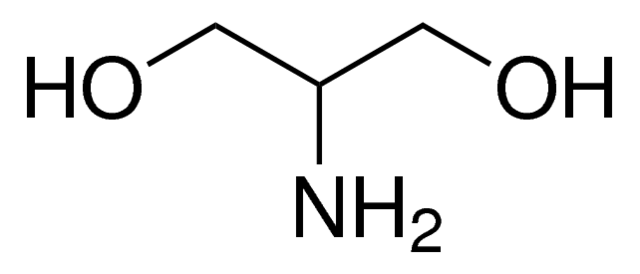Seema Finechem Industry LLP based in Navi Mumbai, India is a pioneer Exporter, Manufacturer and a Major Supplier of Serinol / 2-Amino-1,3-propanediol (CAS No. 534-03-2) at a most competitive price and assured quality.
The term "Serinol" also describes the group of C-substituted commercial analogs. As it is the case for most amino acids, serinol and its derivatives are often used intermediates in several chemical applications. In many organisms mostly eukaryotic serinol derivatives function as central second messengers. In a few prokaryotes, serinol occurs as an intermediate of toxin synthesis. Here, we review the biological and chemical synthesis and applications of serinol and of some of its derivatives.
Contrast Media Applications
The amino alcohols which have the physical and chemical characteristic of both alcohols and amines in one molecule. Amino alcohols are highly useful materials for a wide variety of applications.
- Chemical intermediate application
- Emulsifier applications
- Coating Applications
- Corrosion inhibition application
- Catalyst applications
- Biochemical Applications

Serinol - Product Description
| CAS NO. | 534-03-2( base), 73708-65-3 ( Hydrochloride) |
| Chemical compound | 2-amino-1,3-propanediol |
| EINECS NO. | 208-584-0 |
| Molecular Formula | C3H9NO2 |
| Molecular Weight | 91.11 |
| PHYSICAL STATE | White to off white crystalline powder |
| MELTING POINT | 520 – 560C |
| BOILING POINT | 1150 – 1160C/14 mmhg hg |
| ASSAY (GC) | 98.0% min |
| WATER | 0.5% max |
| SOLUBLE IN WATER | Miscible |
| NFPA RATING | Health: 1 , Flammability : 0 , Reactivity: 0 |
| STABILITY | Stable under ordinary conditions |
| HAZARD CLASS | 8 (Packing Group : II ) |
| UN NO | 2735 |
Serinol 98% (2-Amino-1,3-propanediol)
It is a small molecule - big impact
2-Amino-1,3-propanediol (1,3-dihydroxy-isopropylamine, aminoglycerin or amino-trimethylenglykol) has a molecular formula of C3H9NO2 belongs to the group of amino alcohols and is prochiral. As it is a structural analogue to the amino acid serine, the common designation is serinol. It is very stable, corrosive, hygroscopic, and dissolves very well in water. It has a molecular weight of 91.11 g/mol, melts at 52 to 56 °C, and has a boiling point of 115 to 116 °C. The amino alcohol serinol (2-amino-1,3-propanediol) has become a common intermediate for several chemical processes
SYNONYMS:
2-Amino-1, 3 –propanediol, DL-SERINOL, 82419-36-1, Serinol 98% , S8002DI-Serinol, 2-Aminoglycerol
2-Amino-1, 3-propaned , 2-AMINO-1,3-PROPANDIOL, 2-Aminopropan-1, 3-diol, 2-AmIno-1, 3-propanediol, 1, 3-dihydroxy-isopropylamine, aminoglycerin or amino-trimethylenglykol
Chemical intermediate applications
The amino alcohols are useful intermediates for a wide variety of synthesis. Many chemical reactions are common to the amino alcohols to form following examples;
-
amides and amide esters with carboxylic acids and organic acid esters
-
amino acids by oxidation of the alcohol and by hydrolysis of the amide
-
diamines with nitro alcohols
-
heterocyclic organic compounds such as oxazoline by dehydration
-
oxazolidine with aldehydes or ketones
-
oxazoline esters and diesters with three moles of an organic acid
-
poly(amide esters) with dibasic acid
-
salts with inorganic acids
Emulsifier applications
Amino alcohols are used for production of efficient anionic emulsifiers and nonionic polyethylene emulsions. They appear in personal care products formulations and show better base strength, lower neutral equivalent, and lower volatility than traditional amine emulsifiers. Amino alcohols are used in personal-care products with the neutralization function of acid raw materials. They render resinous materials water-soluble. They provide base strength values with low odor levels, good water and alcohol solubility and color stability in cosmetics.
Coating application
The difunctionality of amino alcohols makes them useful as raw materials in polymer applications in both water- and solvent-based to increase the solubility of other components and improve solution stability. They function as a pigment dispersion-aid dispersant to enhance the wetting and viscosity stability. The salts of the amino alcohols are also used in coating to improve the package stability.
Corrosion Inhibition application
Amino Alcohols maintain a constant alkalinity in the boiling water flows and condensate not to form solid products which would impede line flow. This function is applied for corrosion Inhibits. They are widely employed in the preparation of water soluble cationic flocculants and ion exchange resins which adsorb solid and colloidal particles by electrostatic attraction. They are used for water treatment, metal treatmet and absorption of CO2 gas.
Catalyst application
The salts of the amino alcohols like not only hydrochloride salts but also nitrate, sulfate, phosphate, and sulfonate salts can be used alone or in combination with other catalysts for balanced curing action with selected textile-resins.
Biochemical application
In biological field, amino alcohol structure is widely found in many drugs especially antihistamines. Shingosine, the major base of the sphingolipids in mammals for signal transmission and cell recognition is an amino alcohol. Amino alcohol compounds are the starting materials in the preparation of beta-lactam antibiotics, humectant for foods and cosmetics, flavouring agents as well as many oral, injectable or topical pharmaceuticals. Amino alcohols are amine buffers used in a variety of medications.
Serinol / 2-amino-1,3-propanediol
2-amino-1, 3-propanediol, which carries the trivial name of serinol, is an organic compound from the group of alkanolamines. It is a prochiral compound that is an intermediate product in the production of various fine chemicals, including drugs. Under standard conditions, it is a solid, which is very soluble in water. 2-amino-1, 3-propanediol is a very stable, hygroscopic and corrosive substance.
The name serinol was chosen because of the structural similarity to the amino acidserine. In extension, derivatives thereof with substituents on the carbons of serinol are also called serinols.
Applications for Serinol
2-amino-1, 3-propanediol has been used in the manufacture of medicines (the antibioticchloramphenicol ) since the 1940s. It is well tolerated by the body and is incorporated into several other pharmaceuticals.
2-amino-1, 3-propanediol is a diol with which polyesters can be prepared which may have biomedical applications.
|
2-Amino-1,3-propanediol Properties |
|
|
Melting point : |
52-55 °C(lit.) |
|
Boiling point : |
277 °C(lit.) |
|
FP : |
>230 °F |
|
Form : |
Adhering Crystalline Powder |
|
Color : |
White to off-white |
|
Water Solubility : |
Soluble in water and alcohol. |
|
Sensitive : |
Hygroscopic |
|
BRN : |
635683 |
|
CAS DataBase Reference: |
534-03-2(CAS DataBase Reference) |
|
NIST Chemistry Reference: |
2-Amino-1,3-propanediol(534-03-2) |
|
EPA Substance Registry System: |
1,3-Propanediol, 2-amino-(534-03-2) |






